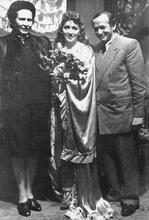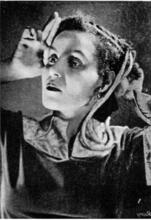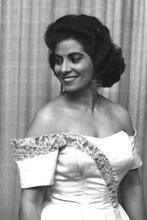Esther Gamlielit
Esther Gamlielit was a talented Yemenite singer, dancer, and actress. As a young woman, Gamlielit belonged to the Biblical Ballet founded by ballerina Rina Nikova in the late 1920s. Through her appearances with the Biblical Ballet, Gamlielit’s talents as a singer also came to light, leading to performances on the "Kol-Yerushalayim" radio station, founded in 1936. As a result of her radio exposure, Gamlielit was invited to participate in the Matate satirical theater troupe, whose musical director, the well-known composer Moshe Wilensky (1910–1997), was also the theater’s house composer. Gamlielit became famous within for her performances of songs with the Yemenite-style pronunciation of the Hebrew letters het and ayin. Gamlielit was prominent in a lineage of Yemenite singers, after Brachah Zefira and before Shoshana Damari.
Article
Esther Gamlielit was born on March 13, 1919, to Yemenite parents who were en route to Palestine by way of Egypt. Once in Palestine, the family settled in the Neveh-Zedek quarter of Tel Aviv, later relocating to the Kerem ha-Temanim quarter of the city.
As a young woman, Gamlielit belonged to the Biblical Ballet founded by ballerina Rina Nikova in the late 1920s. The troupe consisted of pupils from Nikova’s dance studio, most of them from Yemenite families. Nikova adapted Yemenite dance steps to biblical themes, which she styled for the stage.
Through her appearances with the Biblical Ballet, Gamlielit’s talents as a singer also came to light, leading to performances on the "Kol-Yerushalayim" radio station, founded in 1936. As a result of her radio exposure, Gamlielit was invited to participate in the Matate satirical theater troupe, whose musical director, the well-known composer Moshe Wilensky (1910–1997), was also the theater’s house composer. Concurrently with her work in Matate, Gamlielit appeared throughout Palestine as part of a trio, together with Jacob Timen and Shmuel Rodensky.
Gamlielit became famous within the theater and beyond for her performances of songs that called for acting and singing with the Yemenite-style pronunciation of the Hebrew letters het and ayin, including “Tango Temani,” “Elimelekh,” “Gedalyah Reva Ish,” “Be-Karmei Teman,” “Ha-Yeled Nissim,” and “Ha-Tender Nosea.”
At one of her performances in Nes Ziyyonah, she met Avigdor Yosifon, who was on guard duty that night. He fell in love with her and they married one week later. Her marriage, at the age of twenty-two, led her to retire from the stage.
On rare occasions, Gamlielit would make one-time appearances that left her audiences highly moved; these included nostalgic shows such as HayoHayuZemanim (1960), where she performed the song “Ha-Tender Nosea,” and Hadran le-Tel Aviv on Israel Television.
Esther Gamlielit constitutes the second link in the chain of Yemenite women singers, after Brachah Zefira and before Shoshana Damari.
Esther Gamlielit passed away on September 17, 2012.
Bar-on, Yaakov. “Esther Gamlielit: A Legend of the Land of Israel.” Habama, November 13, 2012.
Friedlander, Nili. “The Queen of the Endearing Song.” Maariv, January 30, 1970. [Hebrew]
Shahar, Natan. Song, Song, Please Ascend: The Birth of the Hebrew Song. Modan: 2006. [Hebrew]















